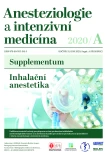Klinická farmakologie inhalačních anestetik – co je nutno znát k atestační zkoušce Oxid dusný
Authors:
P. Štourač; T. Musilová
Authors‘ workplace:
Fakultní nemocnice Brno
; Masarykova univerzita
; Lékařská fakulta Masarykovy univerzity
; Klinika dětské anesteziologie a resuscitace
Published in:
Anest. intenziv. Med., 31, 2020, č. Supplementum A, s. 5-6
Overview
Nitrous oxide is a gaseous inhalational anesthetic. It has been used for anesthesia since the second half of the 19th century. Its advantage is the analgetic and anxiolytic effect. Nitrous oxide does not produce sufficient anesthetic effect when is used alone. It is mainly used as an adjuvant anesthetic in combination with other inhalation anesthetics. It reduces the effect of other anesthetics and reduces their consumption. It is not metabolised, but it interferes with the metabolism of vitamin B 12- dependent enzymes. It is eliminated mainly by the lungs. The mechanism of action is inhibitory interaction with GABA and NMDA receptors. It is especially suitable for pain reduction during delivery or the sedation in minor surgical procedures. The most common side effects are postoperative nausea and vomiting.
Keywords:
inhalation anesthetics – analgesia – obstetric – vitamin B 12
Sources
- Barash PG, Cullen BF, Stoelting RK. Klinická aneste-ziologie. 6. vydání. Praha: Grada; 2015, ISBN: 978-80-247-4053-9.
- Larsen R. Anestezie. 7. vydání. Grada Publishing; 2004, ISBN80-247-0476-5.
- Švihovec J, et al. Farmakologie. Grada Publishing; 2018, ISBN: 978-80-247-5558-8.
- Allman K, Wilson I, O‘Donnell A. Oxford Handbook of Anaesthesia. Fourth Edition. Oxford university press; 2016.
- Butterworth JF, Mackey DC, Wasnick JD. Morgan and Mikhail’s Clinical Anesthesiology. McGraw-Hill Education; 2018.
- Hess L. Oxid dusný. Remedia. 2011; 5: 364–371.
- Leung JM, Sands LP, Vaurio LE, Wang Y. Nitrous oxi-de does not change the incidence of postoperati-ve delirium or cognitive decline in elderly surgical patients. Br J Anaesth. 2006 Jun; 96(6): 754–60. doi: 10.1093/bja/ael106. Epub 2006 May 2. PMID: 16670110.
Labels
Anaesthesiology, Resuscitation and Inten Intensive Care MedicineArticle was published in
Anaesthesiology and Intensive Care Medicine

2020 Issue Supplementum A
Most read in this issue
- Inhalational anesthetics in current anesthetic practice
- Desfluran
- How to administer inhaled anesthetics correctly
- Sevofluran
